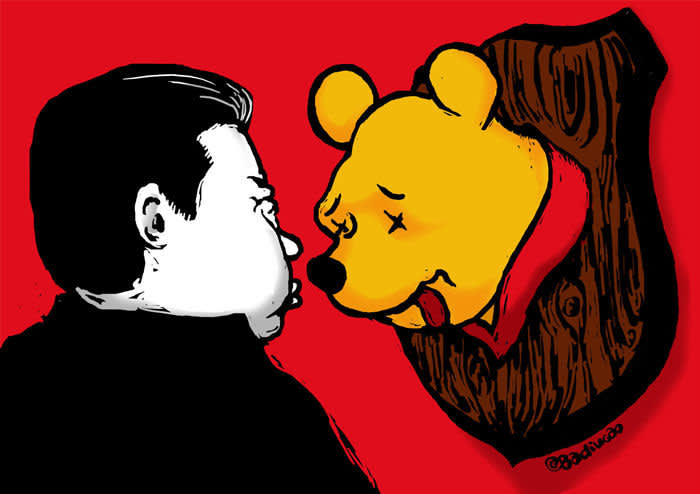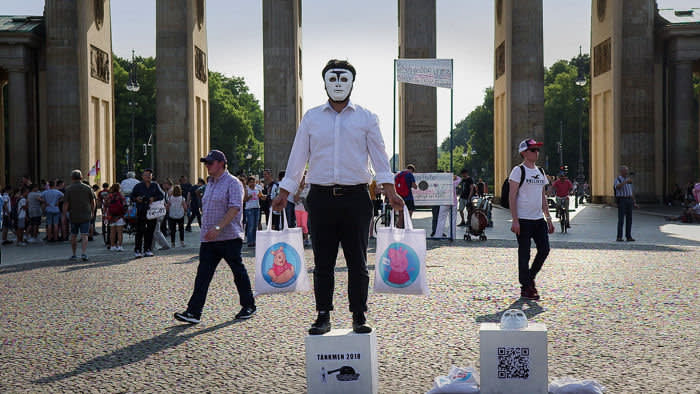Chinaã¢ââ¢s ââëœartful Dissidentã¢â⢠Beats Censors With Viral Cartoons Ft
Receive free Visual Arts updates
We'll send you a myFT Daily Assimilate email rounding up the latest Visual Arts news every morning.
Political cartoonist Badiucao has appeared in public wearing a multicoloured ski mask with the rima oris sewn shut and disguised himself every bit a woman in a wig and big sunglasses in a bid to shield his identity from the authorities in his native China.
Simply despite his efforts to remain anonymous, the Australian-based creator of cartoons poking fun at the Beijing government has recently felt forced to reveal his face up in social club to stand to growing pressure from those in power.
Badiucao, a name made upward of three Chinese characters picked at random then as to exist gibberish, says his art is a class of resistance. The work he publishes online pushes back against Beijing's official narrative and is designed to be highly shareable in order to evade government censors. "What could be more efficient to defeat censorship than making it viral?" he says.
The realisation that the Chinese government has discovered his identity dawns on him in the Australian documentaryChina's Artful Dissident, which tracks the artist every bit he prepares for a evidence in Hong Kong. The picture show, which aired recently on Australian TV on the 30th anniversary of the Tiananmen Foursquare crackdown, shows Badiucao weighing his wish to protect his family unit withal living in Red china against his desire to display his work on Chinese soil. The exhibition was eventually called off over prophylactic concerns.

Now living in Melbourne, the dissident artist is a member of the generation built-in in the 1980s that has mostly benefited from People's republic of china's rapid economic growth. He studied law at university and saw human rights law equally a possible career path, just later grew disillusioned with life in China and emigrated. He is self-taught as an artist, having been discouraged from pursuing a life in the arts equally a kid as it was considered also dangerous in light of his family'south tragic history.
His grandfather and great uncle were both pioneers in Communist china'southward motion-picture show manufacture, just became victims of Prc'due south Hundred Flowers Campaign. This motion, which began in 1956, saw intellectuals invited past the Communist party to criticise its policies. Notwithstanding, every bit the criticism escalated, many were sent to the countryside for difficult labour or were imprisoned. Badiucao's grandfather died in unknown circumstances at such a labour camp. "He just evaporated," the artist says.

Badiucao first shared his cartoons on Weibo, China's equivalent of Twitter, with an epitome commenting on the 2011 Wenzhou runway crash, which killed forty people. Every bit authorities scrabbled to suppress reporting on the accident in newspapers, discussion took off online, where censors had yet to impose control fully.
"I don't think they'd quite figured out what social media was about," Badiucao says. "The applied science and their awareness had not caught up, which leaves a kind of space on the internet."
Badiucao was surprised by the lively discussion on Weibo. "Nigh of the time, Chinese are quite quiet, they don't talk virtually politics. They might talk most it at the dinner table, but they don't talk nearly it in public like the netizens did online," he explains.
That online freedom did not last long. Censors closed his account down 37 times, and despite forming a marriage with other cartoonists to promote ane another's works, he gave upward on the microblogging site and decamped to Twitter. "It's nearly like being a cyber world refugee," he jokes.

Charlie Smith of Greatfire.org, a censorship watchdog, says the train crash marked a switch from ad hoc censorship to professionalised engineering science-driven controls that accept get increasingly sophisticated under President Xi Jinping. "Twelvemonth afterwards year, more websites, search terms, photos and subjects have been added to the censorship blacklists, and rarely practise they ever come off those lists," Smith says.
The adoption of bogus intelligence by censors has had a wider touch on on costless speech, says Yaqiu Wang of Human Rights Watch. "It has definitely further chilled spoken language online. From what I've observed, there accept been even fewer posts on politically sensitive issues, either because netizens tin't become them posted or are afraid to post them in the outset place."
The artist has produced cartoons depicting Xi ageing into a skull in a suit subsequently he removed leadership term limits, and as Winnie the Pooh, following a meme that took off when a photo of Xi with President Barack Obama sparked comparisons to Pooh and led to a ban on the impact the Chinese internet.
Badiucao says the ideas expressed in his art are seen as a threat by the Chinese government. "As a political artist, I have a power that is out of their control, and they know how dangerous it could be to them. That is why they are hunting downwards artists like me."
His concerns are not unfounded. Chinese artist Ai Weiwei was abducted and detained for three months by Chinese security agents in 2011 without charge, following a series of works that focused on politically sensitive topics, such every bit the 2008 Sichuan earthquake. Ai'due south studio, Beijing Simulated Cultural Evolution, was fined Rmb15m for tax evasion, which the creative person denied, claiming it was levied as retribution for his political activities
Badiucao'south piece of work now too exists in the physical world. One piece of work is a cartoon he created from a photograph of the writer Liu Xiaobo, China's only Nobel Peace Prize Laureate, and his wife Liu Xia, a day before Liu died from cancer in detention, and pasted on Melbourne's Hosier Lane. The original film of the couple was being deleted by Chinese censors online, so he took his replica to the street art lane as a personal tribute. When he returned subsequently Liu'south death, Badiucao constitute flowers, candles and cards placed below the image.
"This is seeing the power of people, seeing the image work," he says. "If you tin can find a powerful plenty prototype, it volition repeat in people'due south hearts."

Badiucao's cancelled Hong Kong show included pieces commissioned from Chinese factories through Taobao, the Alibaba-owned online marketplace. One piece of work, a "tiger chair" fitted with restraints used to immobilise detainees during interrogation, with a special rocking chair base, was designed to highlight Prc's role as an exporter of torture equipment.
Finding factories to create these pieces was a political statement, Badiucao explains. "For me, it's full of take chances because I never know if the factories volition notice this is political piece of work and won't want to brand it. But perhaps considering they just want to make money, or perchance the censorship system is so successful that they don't even recognise that information technology is bad stuff, that it is sensitive stuff. And because of that absurdity, they made information technology and they mailed information technology to Hong Kong."
The metropolis was back in the creative person's thoughts equally he reappeared from a cocky-imposed period of reflection to coincide with massive protests in Hong Kong final month. His latest work ridicules the territory'southward leader, Carrie Lam, after she cried what people say were crocodile tears in a television interview. Badiucao's drawing shows Lam in her signature cheongsam clothes equally a reptilian hand dabs away the tears.
Source: https://www.ft.com/content/250d7ed2-a488-11e9-974c-ad1c6ab5efd1
0 Response to "Chinaã¢ââ¢s ââëœartful Dissidentã¢â⢠Beats Censors With Viral Cartoons Ft"
Post a Comment